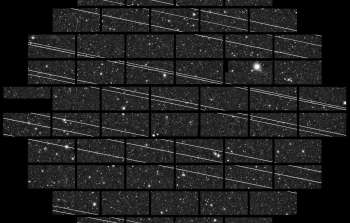sci20094 — Announcement
Results of the SATCON1 Workshop
July 18, 2020
Earlier this month, NSF’s NOIRLab and AAS, with support from NSF, hosted the Satellite Constellations 1 (SATCON1) workshop (29 June - 2 July 2020). Held virtually with approximately 250 attendees, the workshop brought together astronomers, satellite operators, dark-sky advocates, and other stakeholders to work toward solutions to mitigate the impact of low Earth orbit (LEO) satellite constellations and to develop a white paper reporting the results.
In the weeks preceding the workshop, four working groups drafted reports summarizing the current state of knowledge in four areas: (1) Results from ground-based observations of satellites and future observing program needs; (2) Current status of and future needs for simulations to assess the impact of satellites; (3) Mitigation strategies through lab measurements of satellite surface reflection and detector performance as well as operational strategies; and (4) Metrics for the protection of optical/IR observations based on the results of the other working groups. Discussions at the workshop are now shaping the final versions of the reports, and summaries of the first three working group reports are provided here.
The Observations Working Group, chaired by Lori Allen, summarized observations to date of satellite constellations and looked at how we can ensure the success of future observational programs. The group finds that there are immediate and long-term needs for broad, coordinated efforts between researchers, observers, astrophotographers, and amateur astronomers to conduct observations of satellite constellations and interpret the data. Through a comprehensive satellite constellation observing network, we can connect observers with telescopes, provide coordinated observing protocols and data analysis standards, characterize the brightness of satellite constellations, test the efficacy of mitigation efforts, and prepare for the next generation of LEO satellites.
The Simulations Working Group, chaired by Pat Seitzer, reported on their simulations of the visibility of large satellite constellations a starting point for estimating its impact on specific science projects. The simulations show that:
- The fraction of satellites visible at any observatory at any one time is about 5%.
- The number of satellites visible is a function of orbital inclination, with the greatest impact on observatories at latitudes close to a satellite’s inclination.
- Satellites at higher orbital altitudes are the most visible, since they are illuminated longer.
- At 550 km and higher, the number of satellites visible between nautical twilight (Sun at -12 deg elevation) and astronomical twilight (Sun at -18 deg elevation) is only marginally smaller than the number visible at sunset. Significant falloff in the number visible occurs only after astronomical twilight in some cases, particularly at elevations above 30 degrees.
The group recommends future simulations to assess (1) the impact of the satellite constellations on science: how often will a specific observation be lost due to a satellite trail, for example, and (2) the impact of the other two phases of a satellite constellation’s lifetime: initial mission phase and deorbit phase.
The Mitigation Working Group, chaired by Tony Tyson, reported on efforts to mitigate the effects of satellite constellations on optical astronomy research. Mitigation options include fewer satellites, fainter satellites, smaller satellites, satellites visible in a smaller fraction of the night-time, high-precision satellite attitude information, improved scheduling capabilities for observatories, improved image processing capabilities, and novel sensors for the future. Large aperture facilities with large fields of view and broad science programs appear to be the most impacted, as well as telescope systems aiming for precision astrophysics (photometry, spectra, low signal-to-noise signal detection).
With tens of thousands of satellites already in orbit before the first Starlink launch in May 2019 and nearly a hundred thousand planned within a decade, the group finds that, in general, no combination of currently known mitigations can completely avoid the impacts of satellite trails on the science programs of the coming generation of optical astronomy facilities. Example science cases where mitigation is particularly challenging include fast transients (with long exposure spectroscopic follow-up), optical-infrared gravitational wave follow-up, rapid contiguous monitoring of special sky areas, detection of potentially hazardous asteroids and ultra-deep sky surveys.
The Metrics Working Group, chaired by Richard Green, is in the process of developing its summary based on the results of the other working groups and their implications for impact on the science done at various observatories.
The workshop’s Scientific Organizing Committee is writing a white paper based on the above working group reports, which will be submitted to NSF by the end of July. The white paper will be made available to the wider community in August. Future planning and policy events, including SATCON2, are also being developed.
Stay tuned for further details! If you are interested to get involved in future events or in the above topics on the impacts of satellite constellations, please contact Connie Walker (cwalker@noao.edu).
Contacts
Connie Walker
Email: cwalker@noao.edu
About the Announcement
| Id: |
ID
sci20094
|
